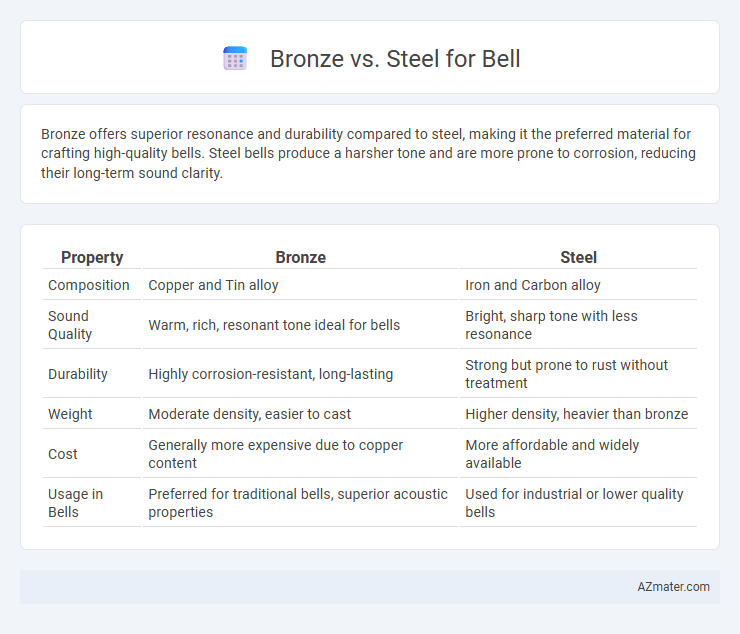Bronze offers superior resonance and durability compared to steel, making it the preferred material for crafting high-quality bells. Steel bells produce a harsher tone and are more prone to corrosion, reducing their long-term sound clarity.
Table of Comparison
| Property | Bronze | Steel |
|---|---|---|
| Composition | Copper and Tin alloy | Iron and Carbon alloy |
| Sound Quality | Warm, rich, resonant tone ideal for bells | Bright, sharp tone with less resonance |
| Durability | Highly corrosion-resistant, long-lasting | Strong but prone to rust without treatment |
| Weight | Moderate density, easier to cast | Higher density, heavier than bronze |
| Cost | Generally more expensive due to copper content | More affordable and widely available |
| Usage in Bells | Preferred for traditional bells, superior acoustic properties | Used for industrial or lower quality bells |
Introduction: The Significance of Bell Materials
Bell materials significantly influence acoustic performance and durability, with bronze and steel being the most common choices. Bronze, typically composed of copper and tin, produces rich, resonant tones favored in traditional bell casting for centuries. Steel offers greater strength and cost-efficiency but tends to emit a sharper, less harmonious sound, making bronze the preferred material for high-quality bells.
Historical Overview: Bronze and Steel Bells
Bronze bells, historically crafted from a copper-tin alloy, have been favored for centuries due to their superior resonance and durability, with origins tracing back to ancient China and Europe. Steel bells emerged during the Industrial Revolution as a cost-effective alternative, offering greater strength but typically producing a less rich and sustained tone. The transition from bronze to steel marked a significant shift in bell manufacturing, balancing economic considerations with acoustic quality.
Acoustic Properties: Sound Quality Comparison
Bronze, particularly bell bronze alloy (about 78% copper and 22% tin), produces a rich, warm tone with superior sustain and complex overtones, making it ideal for high-quality bells. Steel bells tend to generate a harsher, brighter sound with less harmonic complexity and shorter sustain, often perceived as less musical. The denser grain structure in bronze contributes to its acoustic resonance, providing a clearer, more sonorous sound compared to the more rigid and less resonant steel.
Durability and Longevity: Bronze vs Steel
Bronze bells exhibit superior durability and longevity due to their resistance to corrosion and consistent tonal quality over time, often lasting centuries with minimal degradation. Steel bells are more prone to rust and structural weakening when exposed to moisture, reducing their lifespan compared to bronze. The inherent alloy composition of bronze, primarily copper and tin, enhances weather resistance and maintains acoustic performance, making it the preferred material for long-term bell use.
Cost and Accessibility of Materials
Bronze, primarily composed of copper and tin, tends to be more expensive due to the higher cost of copper and the complexity of alloying, making it less accessible for large-scale bell production. Steel, largely made from iron and carbon, is more affordable and widely available, offering a cost-effective alternative for bell manufacturing. However, steel may lack the traditional tonal quality and corrosion resistance that bronze provides, influencing material choice based on budget constraints and acoustic requirements.
Casting and Manufacturing Processes
Bronze, primarily a copper-tin alloy, offers excellent castability due to its fluidity and resistance to shrinkage, making it the preferred material for traditional bell casting with precise tonal qualities. Steel, while stronger and more durable, poses challenges in casting because of its higher melting point and tendency to form impurities, often requiring forging or machining rather than traditional casting methods. The manufacturing process for bronze bells involves sand casting or lost-wax casting to achieve fine detail and acoustic precision, whereas steel bells often rely on welded or spun manufacturing techniques that impact sound characteristics and production efficiency.
Maintenance and Care Requirements
Bronze bells require less maintenance due to their natural corrosion resistance and patina formation, which protects the surface from rust and environmental damage. Steel bells, while often more affordable, demand regular cleaning, coating, and rust prevention treatments to maintain sound quality and structural integrity. Proper care of bronze includes occasional polishing and inspection, whereas steel bells necessitate consistent upkeep to prevent corrosion and ensure longevity.
Cultural and Traditional Preferences
Bronze is historically preferred for bells due to its rich sonic qualities and cultural significance in many traditions, especially in Asian and European ceremonies. Steel bells, while more durable and cost-effective, are often viewed as less authentic and can produce a sharper, less melodious tone, influencing their acceptance in religious and cultural contexts. The choice between bronze and steel reflects deep-rooted cultural values tied to sound quality, craftsmanship, and tradition.
Environmental Impact of Bell Production
Bronze bells, primarily composed of copper and tin, require mining processes that can cause significant environmental disruption, including habitat loss and energy-intensive extraction. Steel bells involve iron and carbon production, often relying on blast furnace methods that emit higher levels of greenhouse gases compared to copper and tin mining. Recycling steel in bell production offers a more sustainable option by reducing raw material extraction and energy use, whereas bronze recycling is less common due to alloy composition complexities.
Choosing the Right Material: Bronze or Steel?
Choosing the right material for a bell involves considering the acoustic properties and durability of bronze versus steel. Bronze, typically a copper-tin alloy, produces a rich, resonant tone with excellent sustain, making it the preferred choice for traditional and high-quality bells used in music and ceremonial contexts. Steel offers greater strength and lower cost but results in a sharper, less harmonic sound, making it suitable for industrial or signaling bells where clarity and durability are prioritized over tonal complexity.

Infographic: Bronze vs Steel for Bell
 azmater.com
azmater.com